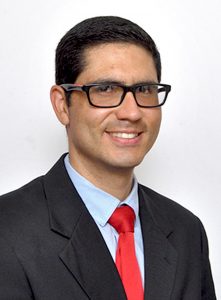 By Dr. Ronny Munoz-Acuna
By Dr. Ronny Munoz-Acuna
I was born and raised in Costa Rica, a small country in Central America with close to 5 million inhabitants. I was always passionate about science, and after debating for a long time, I decided to pursue training in medicine. I did my medical school in San José, Costa Rica, at the Universidad de Costa Rica. I also completed a residency in Internal Medicine and a fellowship in Critical Care in my home country.

I decided to pursue further medical training in the US, to familiarize myself with the intra- and post-operative care of solid organ transplantation and cardiac surgery patients, extracorporeal support, transesophageal echo, and to improve my research skills. All of this led me to pursue a residency in Anesthesia and then fellowships in Critical Care Medicine and Cardiothoracic Anesthesia. I did my internship at MetroWest Medical Center in Framingham, Massachusetts, and my residency at the Beth Israel Deaconess Medical Center in Boston, Massachusetts, where I am currently an ICU fellow.
As COVID began, we heard news of China’s events, and the ones that were happening in Italy and other European countries. New York became an epicenter for the pandemic on the East Coast. Shortly after, we started feeling the pressure in the various ICUs. By early April, some of the inpatient floors and post-anesthesia care units were being transformed into ICUs. At that time, when they asked us to assist, I knew my duty was to step out of the OR and to help in one of these units. We started to see more and sicker patients, with a vast array of syndromes caused by COVID-19.

The most significant intellectual challenge was taking care of 8 to 12 patients at a time who were very sick. Some of them needed special procedures like central lines or HD catheters, or were required to be prone to achieve adequate oxygenation, while taking care of the anesthesia machines, circuits, filters, flows, and gases and at the same time trying to make sure we were not missing critical details like having the patient on the right antibiotics, vasopressors, nutrition, and fluids. In contrast to our usual variety of pathology, these patients all had very similar yet subtly distinct presentations. Clinically, it was surprising to me the many manifestations of COVID in each patient—there are no two alike. It was challenging to care for these critically ill patients, outside of our normal ICUs, while wearing many layers of PPE for long hours.

The most significant emotional challenge was trying to make sure our patients’ families knew that everything was being done to offer their loved ones the best possible care. We had to be a bridge connecting patients with their families, making sure everyone felt listened to and cared for. The entire team was also worried about keeping themselves safe. It was always hard thinking about the possibility of infecting our families, which for me meant putting my wife and my little 18-month-old daughter in danger.
What surprised me the most was the immense support from the Boston community. Everyone helped the best way they could: there were positive text messages and signs around the hospital, donated lunches, coffee, and protective gear. Our residency program excelled in ensuring we had enough emotional support, enough PPE, and enough supervision to deal with these complex patients. I never felt like I was alone or putting myself or others at risk.

All the hospital staff became one giant team, working to achieve one goal: give excellent care to people who needed it. We all had a common mission in mind, and everyone was giving their best. Through all of the uncertainty and complexity of these patients’ care, everyone working together made things as smooth as possible.
It is impossible to live through this and still be the same. For many years I thought that as physicians, we had a duty to help. I now realize it is more than a duty—it is a gift to help and to bring hope to families and patients. Our message must always be resiliency amid adversity.
